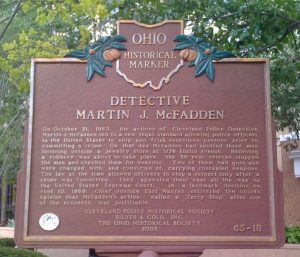Today, Sunday, June 10th, is the 50th Anniversary of Terry v. Ohio, 392 U.S. 1 (1968). Ohio’s Eighth District Court of Appeals opinion is also noteworthy, drawing on common law and whatever recent authority there was, considering the court of appeals decided its case in 1966, and the officer’s 39 years experience [that means he started in 1924] that Terry and Chilton were up to no good, casing a jewelry store. Terry’s stop and frisk was Halloween 1963. The court of appeals made it clear the right to frisk was limited to weapons, to balance the gravity of need against the intrusion. And, it’s opinion was 28 months before SCOTUS’s. State v. Terry, 5 Ohio App. 2d 122, 214 N.E.2d 114 (1966). Louis Stokes argued for Terry, and he was later a legendary Congressman from Cleveland. Jack Day was co-counsel with Stokes in SCOTUS. He was NACDL President at the time.
There is an historical marker across the street where Det. McFadden was standing as he watched Terry and Chilton case the jewelry store. It was placed in 2003. I did a CLE in Cleveland in 2008, and I was taken by the FPD to the spot, still important to the local legal lore.


Terry is usually known to many as just the first “stop and frisk” case, but it is so much more to the Fourth Amendment and the concept of “reasonableness” and scope of search.
“This Court has held in the past that a search which is reasonable at its inception may violate the Fourth Amendment by virtue of its intolerable intensity and scope.” Id. at 17-18.
“And in determining whether the seizure and search were ‘unreasonable’ our inquiry is a dual one—whether the officer’s action was justified at its inception, and whether it was reasonably related in scope to the circumstances which justified the interference in the first place.” Id. at 19-20.
“The scheme of the Fourth Amendment becomes meaningful only when it is assured that at some point the conduct of those charged with enforcing the laws can be subjected to the more detached, neutral scrutiny of a judge who must evaluate the reasonableness of a particular search or seizure in light of the particular circumstances. And in making that assessment it is imperative that the facts be judged against an objective standard: would the facts available to the officer at the moment of the seizure or the search ‘warrant a man of reasonable caution in the belief’ that the action taken was appropriate? Cf. Carroll v. United States, 267 U.S. 132 (1925); Beck v. Ohio, 379 U.S. 89, 96-97 (1964). Anything less would invite intrusions upon constitutionally guaranteed rights based on nothing more substantial than inarticulate hunches, a result this Court has consistently refused to sanction.” Id. at 21-22.
Terry is easily the most cited SCOTUS decision. I have no data on that: it’s just an observation.